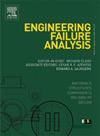Super304H不锈钢连铸生产中喷嘴堵塞失效分析
IF 4.4
2区 工程技术
Q1 ENGINEERING, MECHANICAL
引用次数: 0
摘要
本文采用系统分析与热力学计算相结合的方法,对Super304H不锈钢连铸过程中浸入式入口喷嘴(SEN)堵塞机理进行了研究。对堵塞的SEN进行解剖,发现其层状形貌包括:(i)初始凝固的钢层(a层),其中包含包裹钢和侵蚀耐火材料;(ii)渣型夹杂层(B层)主要由Al-Ca-Si-Mg-F-O夹杂物组成,由于界面氧化和热梯度,Al2O3含量升高,液相分数减少;(iii)嵌埋在凝固钢中的致密堵塞层(C层),由渣源性和内生夹杂物组成。结果表明,在中间包阶段,高al2o3夹杂物的形成及其聚集成多孔网络严重阻碍了熔体流动,从而引发堵塞。为了抑制B层的形成,包裹体中Al2O3含量应控制在56%以下。此外,将总氧(T.O)含量保持在0.0049-0.0075 wt%的范围内,可确保包裹体的液相比超过50%,从而降低流动堵塞的风险。研究结果为先进不锈钢制造中缓解SEN堵塞、提高连铸产品质量提供了科学依据和过程控制策略。本文章由计算机程序翻译,如有差异,请以英文原文为准。
Failure analysis of nozzle clogging during Super304H stainless steel continuous casting production
This study elucidates the clogging mechanisms of the submerged entry nozzle (SEN) during the continuous casting of Super304H stainless steel through an integrated approach combining systematic analysis and thermodynamic calculations. The dissection of a clogged SEN revealed a stratified morphology comprising: (i) an initial solidified steel layer (Layer A) containing entrapped steel and eroded refractory; (ii) a slag-type inclusion layer (Layer B) predominantly composed of Al-Ca-Si-Mg-F-O inclusions with elevated Al2O3 content and diminished liquid phase fraction, attributed to interfacial oxidation and thermal gradients; and (iii) a dense clogging layer (Layer C) consisting of both slag-derived and endogenous inclusions, embedded within solidified steel. It was demonstrated that during the tundish stage, the formation of high-Al2O3 inclusions and their aggregation into a porous network critically impede melt flow, thereby initiating clogging. To suppress the formation of Layer B, the Al2O3 content in inclusions should be constrained below 56 %. Furthermore, maintaining the total oxygen (T.O) content within the range of 0.0049–0.0075 wt% ensures a liquid phase ratio of inclusions exceeding 50 %, thereby mitigating the risk of flow blockage. The outcomes of this study provide a scientific basis and process control strategy for the mitigation of SEN clogging and the enhancement of continuous casting product quality in advanced stainless steel manufacturing.
求助全文
通过发布文献求助,成功后即可免费获取论文全文。
去求助
来源期刊

Engineering Failure Analysis
工程技术-材料科学:表征与测试
CiteScore
7.70
自引率
20.00%
发文量
956
审稿时长
47 days
期刊介绍:
Engineering Failure Analysis publishes research papers describing the analysis of engineering failures and related studies.
Papers relating to the structure, properties and behaviour of engineering materials are encouraged, particularly those which also involve the detailed application of materials parameters to problems in engineering structures, components and design. In addition to the area of materials engineering, the interacting fields of mechanical, manufacturing, aeronautical, civil, chemical, corrosion and design engineering are considered relevant. Activity should be directed at analysing engineering failures and carrying out research to help reduce the incidences of failures and to extend the operating horizons of engineering materials.
Emphasis is placed on the mechanical properties of materials and their behaviour when influenced by structure, process and environment. Metallic, polymeric, ceramic and natural materials are all included and the application of these materials to real engineering situations should be emphasised. The use of a case-study based approach is also encouraged.
Engineering Failure Analysis provides essential reference material and critical feedback into the design process thereby contributing to the prevention of engineering failures in the future. All submissions will be subject to peer review from leading experts in the field.
 求助内容:
求助内容: 应助结果提醒方式:
应助结果提醒方式:


